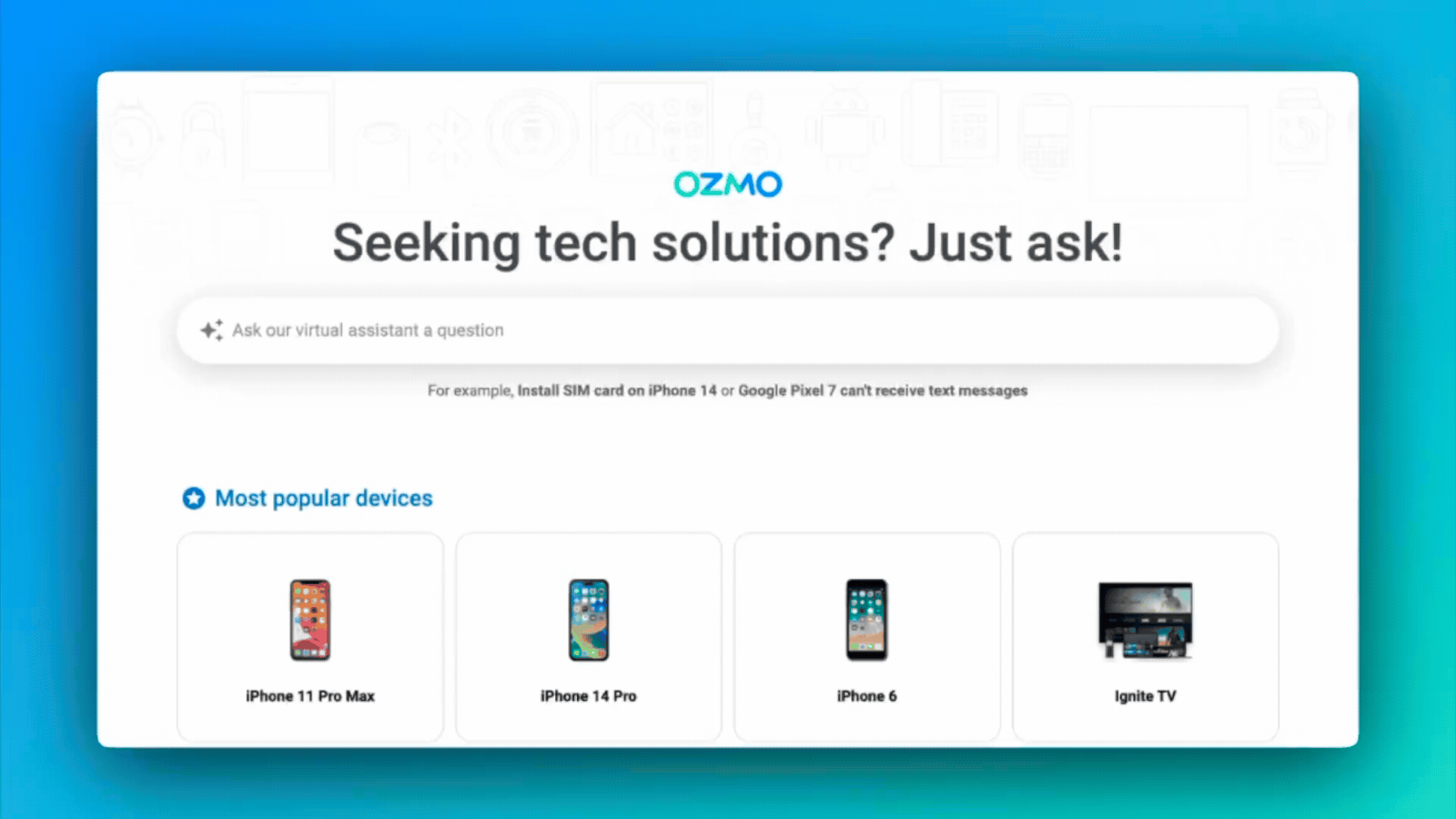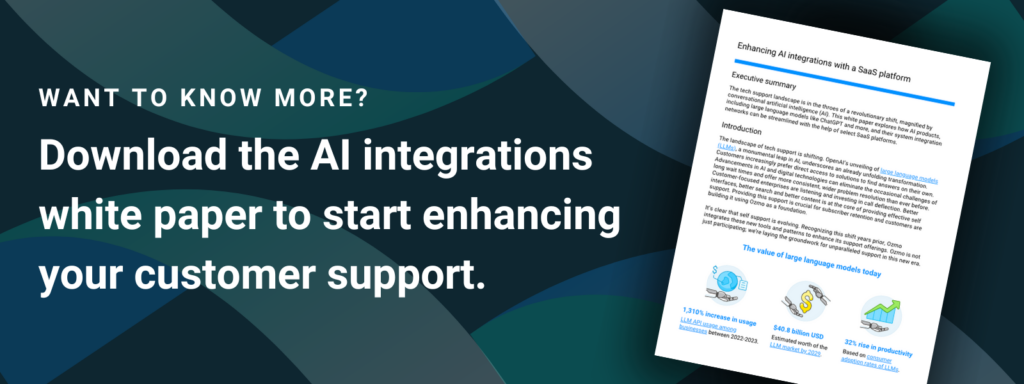Is your chatbot outdated? It’s hard to believe, but the answer may be yes. Rapid innovations in AI have positioned large language learning models, also known as LLMs, to dominate the market. Adoption of LLMs by businesses increased by more than 1,300% in just one year.
LLMs have the power to help customer service teams scale their tech support to provide faster and more accurate customer service. Businesses that rely on chatbots using prescription responses are at risk of being left in the dust.
But what exactly are LLMs, and how can you use them effectively in your tech support strategy? Below, we go over what LLMs are, how they differ from previous chatbot technology and how they can help you stay competitive in increasingly crowded telecom and broadband markets.
What are large language learning models (LLMs)?
Large language models are generative AI models capable of understanding human language and generating natural-sounding, conversational responses.
But how do LLMs work? When the customer or agent asks the chatbot a question, the LLM conducts a vector or semantic search in your knowledge library to find the relevant information. The answers are then summarized and returned. LLMs can provide answers across agent workspaces, virtual assistants or advanced search tools.
How are LLMs different from previous AI models?
Previous chatbots relied on pre-scripted, static answers. They look for specific keywords to answer a customer's question. However, humans aren't pre-programmed and may use various terms when discussing the same issue.
This means these chatbots are severely limited in providing adequate customer service. If the customer doesn't use the exact word or phrase, it won't be able to answer their question, which can lead to frustration or require multiple touchpoints to resolve a tech support issue. All of this has the potential to increase your customer churn rate.
LLMs use natural language processing to understand the context of a customer's question, even if they don't use an exact keyword. They'll know synonyms and various phrases people might use to talk about the same topics. They can also ask follow-up questions to clarify what a customer needs help with.
What does this look like in practice? Let's say a telecom customer receives a higher-than-normal bill with an add-on to their data plan they didn't ask for. They believe your company's billing department did this in error. That customer might type into the chatbot: "I need to dispute a charge." A chatbot that only relies on pre-scripted responses might not understand that because it's looking for the word "billing."
However, a chatbot that uses LLM technology might say: "It looks like you're having an issue with your latest bill. Do you want to dispute a fee?" Because it understands the context of the customer's query, it can quickly and effectively address the issue and direct them to the relevant information.
Does adoption of LLM technology mean I no longer need call center agents?
The short answer is no. AI can’t replace humans, who still have a vital role in tech support. According to the National Customer Rage survey, the number one frustration among customers is the inability to speak to a person.
Additionally, studies show that using real people in your call center is critical for boosting profits and creating a better customer experience. The future of customer service isn’t exclusively relying on AI or people. Businesses seeking to future-proof their tech support departments must implement a combination of AI and human expertise.
In our previous example, AI could understand that the customer needs help with their bill but would need to direct the customer to an agent to correct the charges. This agent can also empathize with the customer, a uniquely human quality, to resolve their issue and create a better experience.
When a customer is overcharged, the agent might respond with, “That is really frustrating, and I apologize for the inconvenience this has caused. In addition to removing the charge, I’m taking 20% off this month’s bill.” Combining the power of people and technology can help agents work smarter, not harder.
How your business can harness the power of Large Language Learning models
LLMs can help future-proof your tech support strategy and stay ahead of the competition. Below, we go over some examples of how you can use this technology to improve the customer service experience.
Scale customer service effectively
Customers’ expectations are higher than ever. Research shows customers expect you to respond to their communications within five minutes or less. Businesses that fail to meet their expectations aren’t given second chances. Nine out of 10 customers will leave after just one bad service experience.
But how can you respond to so many customers in so little time? LLM-based chatbots can help customers skip the call center queue and get the instant answers they need. They also empower you to juggle more service requests without hiring more staff. And because chatbots don’t need to sleep, your customers can also access tech support at any time of day or night. LLMs make it easy to scale tech support for both nationwide and regional service providers.
The ability to scale support without having to hire and train a huge number of new agents can lead to potential cost savings. In addition, it can also help regional service providers compete against larger carriers.
Provide more accurate self-service troubleshooting

Good customer self-service is no longer a nice-to-have but a must-have for your business. 88% of customers expect your company to provide self-service options.
However, traditional self-serve options are often poorly designed, making it difficult for customers to troubleshoot connectivity issues, dropped calls or router malfunctions. The pre-scripted responses, inability to understand the context of requests or lack of guidance can increase customer frustration.
For example, if a customer is having trouble with their router’s connection, previous models of chatbots might tell them to restart their router. This can be frustrating, especially if they’ve already done this five times.
An LLM can understand the nuance of a customer’s question and interpret error codes, enabling the chatbot to provide more accurate and effective solutions to the customer. It can also provide step-by-step guidance using easy-to-understand language or interactive media to direct the user to the appropriate actions.
In the example of the disconnected router, an LLM-based chatbot might guide how to check for and install critical updates. Not only can they do it in a text format, but they can serve up answers from your knowledge base in the form of interactive tutorials. This way, you can show, not just tell, customers how to troubleshoot device issues independently.
As customers receive fast and effective self-service support, you can increase digital adoption rates, customer satisfaction and brand loyalty. Additionally, this can reduce call volume, leading to valuable cost savings.
Reduce call center workload & agent support
Call center agents spend a lot of time handling simple, frequently asked questions, which creates longer wait times. As a result, case burdens and business expenses can increase.
Higher caseloads also come with the risk of employee burnout. Considering it can cost up to twice an employee’s salary to replace them, reducing agent attrition is paramount to the success of your call center.
Once again, LLMs can help. LLM technology can pre-screen customer inquiries before connecting them to a human agent. Additionally, many LLM-based chatbots can effectively answer frequently asked questions, eliminating the need to connect to an agent.
As a result, agents can enjoy a reduced caseload, decreasing the risk of turnover and burnout. It also frees agents to spend more time working on tech support inquiries requiring human expertise.
Additionally, agents who aren’t overburdened by cases tend to be more engaged at work, and research shows employee engagement is critical for a positive customer experience. Happier agents lead to happier customers, which is a win-win for your business.
Embrace the power of LLMs to level up your tech support
The rapid adoption of AI technology is drastically changing customer service as we know it. The introduction of LLMs allows companies to supercharge tech support in a way that traditional chatbots simply can’t.
Harnessing the power of LLMs allows your call center to provide a better customer self-service experience while effectively scaling your tech support. The bottom line? This technology can create a win-win situation for your customers and your business.

Are you looking for more information on using large language learning models to improve your tech support? Our free whitepaper discusses how you can streamline AI implementation with select SaaS platforms, as well as the key benefits of using LLM technology. Download your copy today!



